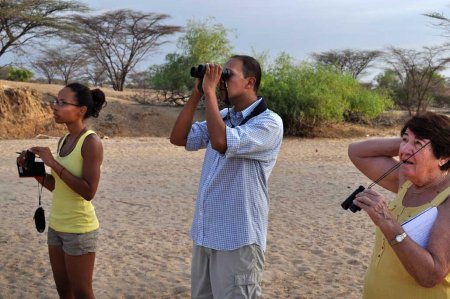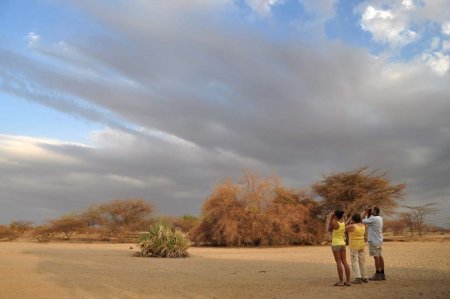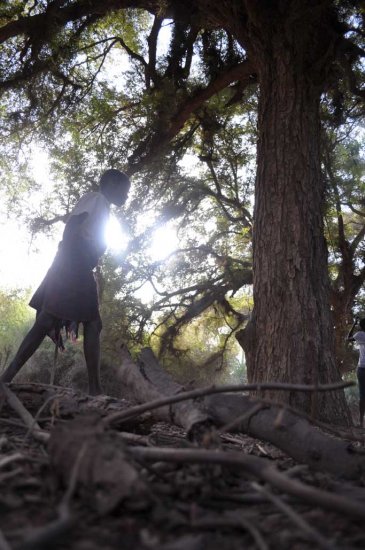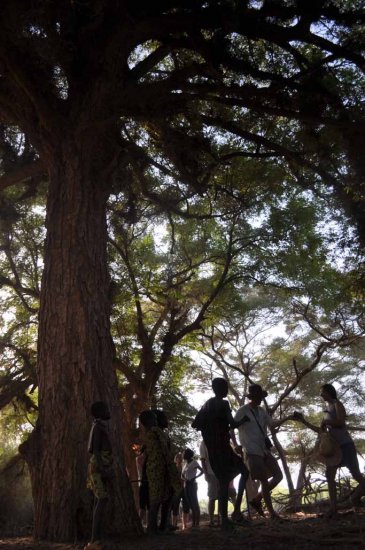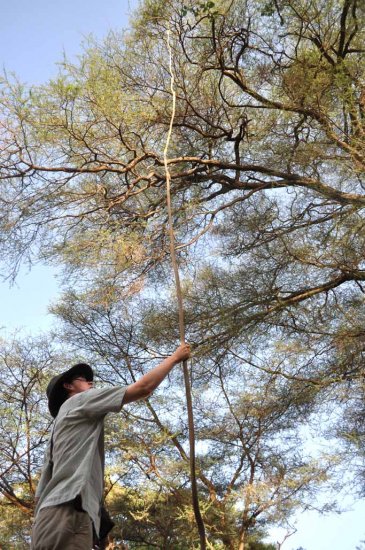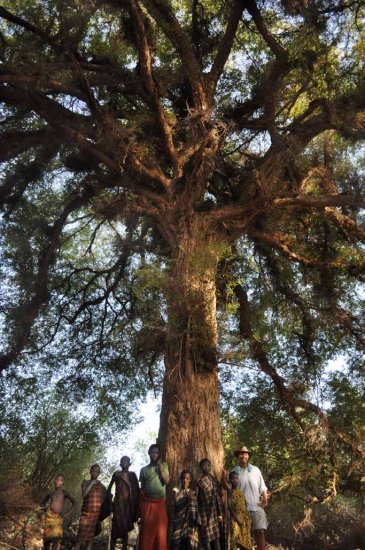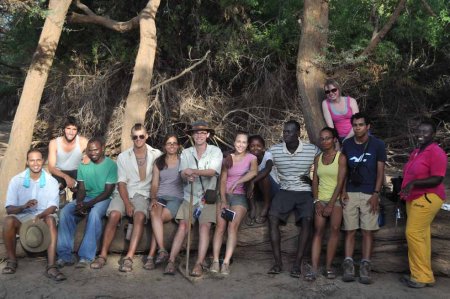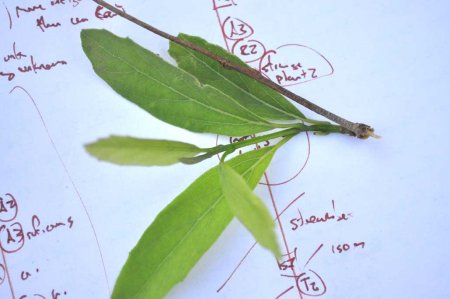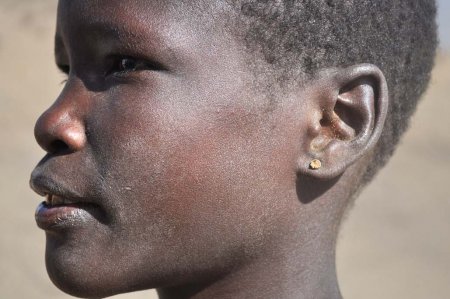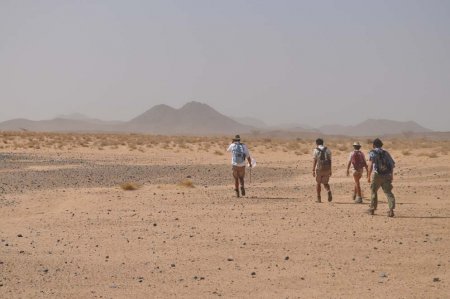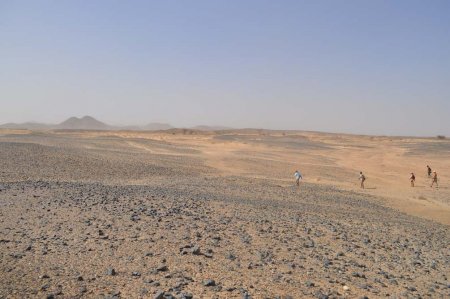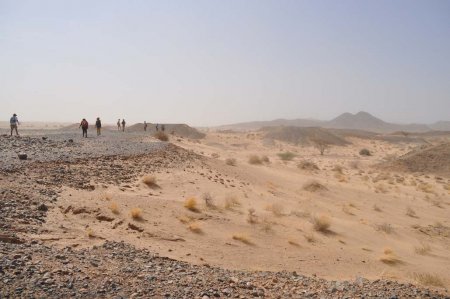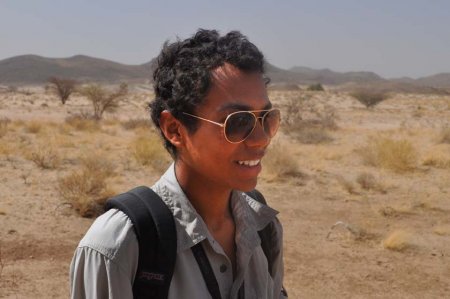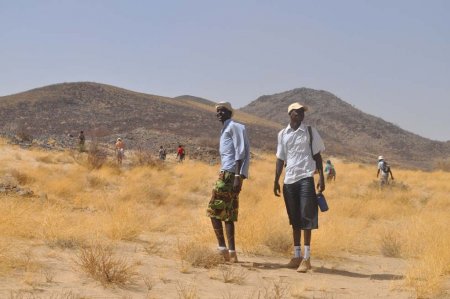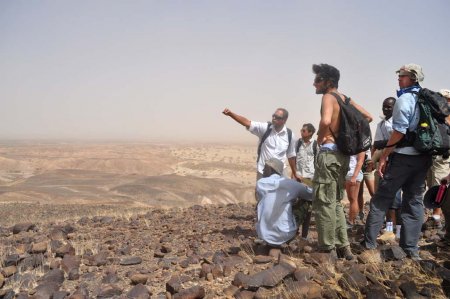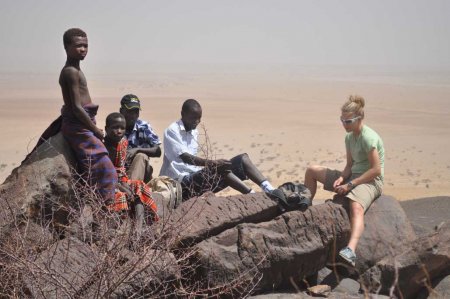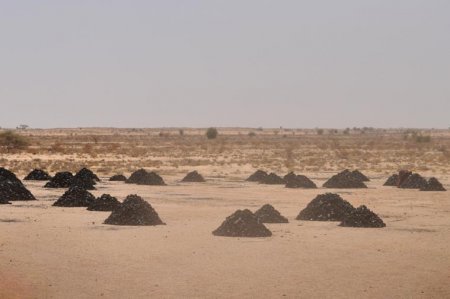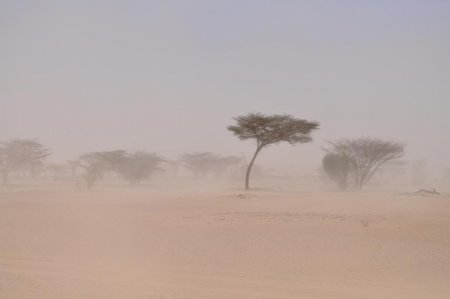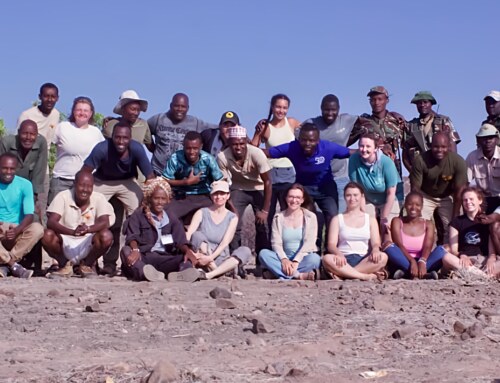Following their exam students headed to the Napudet Hills, a lonely series of Miocene outcrops surrounded on all sides by wide steppe and desert. While the landscape appeared desolate, students found evidence of a great diversity of desert-adapted animals including wild cats, falcons, skinks and many insects.
Close to completing their course on the modern ecology of the Turkana Basin, students hiked to an old growth tree grove adjacent to the Turkwel River. The grove, with a massive tamarind at its center supporting orchids and monkeys, is a local site of gatherings and ceremonies, and considered holy by some.
Following their exam students headed to the Napudet Hills, a lonely series of Miocene outcrops surrounded on all sides by wide steppe and desert. While the landscape appeared desolate, students found evidence of a great diversity of desert-adapted animals including wild cats, falcons, skinks and many insects.
|
Dino and Turkana children gather around the trunk of a massive Tamarind tree, in a grove sacred to the local people here.
|
Living in the desert for six weeks, students have become accustomed to broad and desolate landscapes whose shades and textures consist in dune patterns, empty stream beds and shifting patterns of rock. Acacias and toothbrush trees thrive where other plants cannot, but they sometimes seem little more than details forgotten on vast beds of sand.
For this reason students were astonished to discover a richly vegetated stand of ancient trees, including a tamarind hundreds of years old, hidden alongside the river and within walking distance of camp. Local Turkana pastoralists and TBI staff explained the importance of the trees not only as a source of material sustenance, but also as a place of meeting, animal butchery and ceremony. As ecologist Dino Martins explained, the grove also hosts an exciting array of unusual orchids which blossom during the wet season.
After their exams, students hiked to Napudet, one of a series of Miocene (23-5 million years old) sites similar to Lothagam on the southern side of Lake Turkana. The hills provided spectacular views of the surrounding landscape and welcome relaxation before the beginning of the field school’s next unit.
Kelly, Dino and Raymonde watch for birds outside TBI’s main camp.
Students chose a variety of personal research projects which they presented at the end of their Ecology field course taught by Dino Martins. Kelly Pugh, of Duke University, chose to student the habits and distributions of birds in areas of dense or sparse foliage. To help her with her project, Dino and paleoecologist Raymonde Bonnefille accompanied Kelly into the field at sunrise.
Clouds passing to the north of camp.
Kelly found that in sparsely vegetated areas, birds of different species cooperatively foraged in the same trees. Bird numbers were, however, much less than in more densely vegetated areas like those within the TBI main camp.
A Turkana shepherd walks beneath his community’s local tamarind tree.
While interviewing local people for their research projects, a number of students learned of a nearby grove in which grow huge acacia, zisyphus and cordia trees, and one tremendous tamarind.
Students and Turkana children dance beneath the branches of the tamarind.
The scale of the old trees and the soft light that filters through their foliage give the grove an otherworldly feeling. Turkana in the area use the tree as a place for public gatherings, ceremonies, and animal butchery; some consider the site sacred.
Ben shakes a staff meant to bring down seed pods for feeding goats.
TBI field school students found this wooden pole, dozens of meters long, hanging from the branches of an old acacia in the grove. Turkana shepherds often use the poles to bring down acacia pods during the dry season, and feed their goats.
Turkana children and Dino Martins beneath the Tamarind.
Tamarind trees are widely used by people and are found thoughout the African tropics, in the Middle East and in southeast Asia. Their leaves are sweet and slightly tart, and can be made into chutneys especially popular for Indian curries.
Dino Martins and TBI students, from left: Wyatt, Johnpius, Peter, Chelsea, Ben, Alisha, Mary, David, Kelly, Kasia, Alec and Julian.
Notes from a student’s fieldbook, with leaves set above.
For their projects students often collected data along transects or within quadrats, classical tools within ecology. Above, a plant later identified as Cordia sinensis is placed above a student’s field notebook describing tree species and ages along the river.
A Turkana shepherd north of Napudet.
Finishing their week with Dino, students headed to the Napeded (or Napudet) hills south of the Turkwel River. The hills are thought to date from the Miocene epoch 5-23 million years ago, and contain fossils from that period, and stone tools of much more recent origin.
Approaching the hills from the north, the lorry was blocked by a dry and sandy streambed, with toothbrush tree bushes and Hyphaene palms along its margins. Two shepherd boys came to watch as TBI students descended from the lorry and began their hike for Napudet.
Dino, Alec, Kelly and Wyatt lead students on their try to Napudet.
Fossils and stone tools litter the landscape en route to Napudet.
Indigophera and grasses on a sandy slope, with Napudet in the distance.
Alec at Napudet.
With his quick pace, Alec often leads students on hikes. During a brief pause for water here he found and showed others the extraordinary root system of an Acacia reficiens, a tree specially adapted to dry environments such as those found in the Turkana Basin.
JohnMark and Francis pause to check all students are safe during the hike up the Napudet hills.
JohnMark Ekeno and Francis Emekui are both local Turkana, with extensive experience in the field and with fossil hunting. Their knowledge of the landscape helps keep students safe during their excursions.
Dino points to the high peak at Napudet.
Climbing higher into the hills, Dino and students aimed for the highest nearby peak and planned a route up. Below, the desert and sandstone beds full of fossils can be seen in the distance.
Turkana shepherds, Francis and Debbie sit on a high hill at Napudet.
The shepherds whom students had originally encountered at the start of their hike came to join them at the top of one of Napudet’s hills.
Trees which have been turned into charcoal.
The practice of charcoal burning, in which older acacia trees are cut, burned and sold to city merchants for about $2 each, leaves many areas desolate.
A dust storm on the way back to camp.


